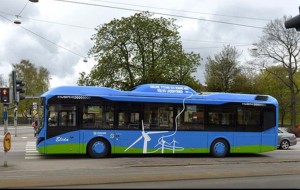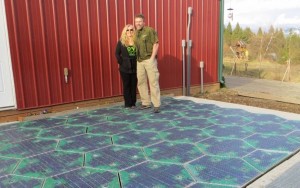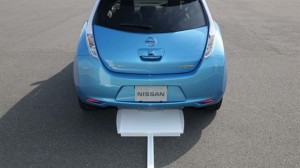While battery cars offer the advantage of zero-emissions driving, they also suffer from a number of disadvantages, notably their limited range and long charging times. But an ambitious new project from Volvo could solve both problems by giving a vehicle a way to charge up while its actually driving.
The maker is working with the Swedish Transport Association to create short stretches of electrified roadway in Gothenberg, the Scandinavian country’s second-largest city. Using a concept called inductive charging, specially designed city buses would simply have to drive along dedicated portions of pavement to partially replenish their batteries. But because there are no exposed wires, the system would be safe for humans and animals who might inadvertently walk across the chargers.
Volvo isn’t the only one looking for ways to use highways to provide power. An Idaho couple has launched a $1 million campaign effort through the Indiegogo crowdsourcing site, while also tapping a $750,000 grant from the Federal Highway Administration, with the idea of developing solar panels that can be used as an alternative to conventional pavement.
While they admit a solar road wouldn’t be as efficient as dedicated solar arrays – and would cost a lot more than asphalt – Scott and Julie Brusaw contend that with 29,000 square miles of road surface in the U.S., the approach could generate a significant amount of power.
(Hyundai-Kia named “greenest” automaker. Click Here to see how it toppled long-time enviro leader Honda.)
Volvo’s project appears to be the most financial viable, at least initially.
The project is the next step in a series of tests designed to see if electric buses can be used in urban application. Three plug-in hybrid buses are already in use on one of Gothenburg’s routes, and they recharge whenever they reach the end of the line. The new buses would stay charged along the way.
“Vehicles capable of being charged directly from the road during operation could become the next pioneering step in the development towards reduced environmental impact,” said Niklas Gustavsson, Executive Vice President of Corporate Sustainability for the Volvo Group.
The electric buses would combine the advantages of trolleys and electric buses, which draw power from overhead wires, and conventional buses that aren’t limited in where they can drive but which have to depend on pollution-spewing internal combustion engines.
(China to force 6 million old, polluting cars off the road. Click Here for the story.)
Other induction charging systems have been put to use in several locations, including limited applications in Utah, Torino, Italy, and Gumi, South Korea. In the latter project, the buses plying a 15-mile run between the city’s train station and In-dong district require battery packs only about a third as big as they’d otherwise need, drawing power as they drive across special charge plates.
The technology is similar to what’s become commonplace for home appliances like electric razors and toothbrushes, a magnet in the ground becoming “tuned” to another on the bus as it drives by, passing power at about 85% efficiency.
If these projects go well, expect to see them expanded substantially. The question is whether similar technology might someday be incorporated into highways for use by electric passenger cars such as the Nissan Leaf and Tesla Model S – perhaps built into existing HOV lanes or dedicated lanes for use by battery cars only. The basics would be much the same. In fact, Nissan is planning to introduce a home induction charger so Leaf owners don’t even have to plug their cars in every day.
(Why doesn’t Fiat Chrysler CEO Sergio Marchionne want you to buy his new battery-car? Click Here to find out.)
Where to get the power, though, is a significant issue – one that the Brusaw believe they can solve with their solar cell pavement.
Scott, who was trained as an electrical engineer, contends that there are enough roads in the U.S. that, if all were converted to the solar pavement system, there’d be enough power to eliminate the use of fossil fuel generators. But he also admits the technology wouldn’t be cheap, estimates running anywhere from 50% to 300% more than for using asphalt to pave a roadway.
And how the material would stand up to weather, road salt in colder climates, snowplows, crashes and other challenges remains to be seen. But the Brusaws hope to address some of those issues now that they have set up a pilot parking lot to demonstrate the capability of their system, which on solar panels embedded in textured glass strong enough, they claim, to support the weight of a 250,000-pound truck – far heavier than almost anything on the road today.
“Finally, we’ve gone from concept to a tangible prototype,” Julie Brusaw recently noted.
The couple are hoping to raise additional funds to take the concept closer to production, and have indicated their first customer may be their hometown of Sandpoint, Idaho.
Beyond selling the solar panels, they’ve been kicking around additional business opportunities, and one possibility could come from providing power to electric buses and cars through induction charging systems on highways across the country.




I love the exaggerations of how great electric power is suppose to be even though everyone ignores the toxic waste issue in favor of claiming that EVs are “emission free”. Then these same people claim modern clean Diesel engines “spew” pollutants into the air. Obviously neither extreme is correct. Electric also contributes to air pollution and toxic battery production and waste via the grid and solar systems that use batteries for storage.
There is no free lunch and just like with the ill fated gasohol scam perpetuated on consumers for great financial profit by a small group of people, eventually people will come to understand that EVs are NOT the end all or be all in reducing air pollution which comes from many sources used to produce EV batteries and electricity.
In the meantime those who profit from EV deception will continue to dupe the naive public who doesn’t bother to even question the absurd claims.